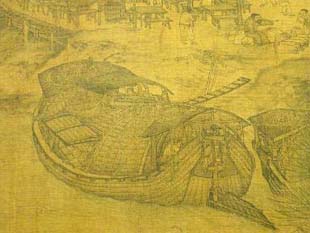Perspective in Comparison
CASE 3
Culture and International Relations in the 18th Century
PERSPECTIVE IN COMPARISON

Foreshortened view of a cargo ship.
Detail from Spring Festival on the River.
Attributed to Zhang Zeduan.
Handscroll, ink and color on silk, 12th century.
Courtesy of Palace Museum, Beijing.
Which is better, European “scientific” perspective or Chinese multiple perspective? Of course, each method has its functions, but this question has been much debated since European artists and Chinese artists first encountered each other in the sixteenth century. Today, we are accustomed to viewing a wide variety of images that are composed according to the rules of perspective. It has become normative, and we really do not think about it very much. A 50-mm camera lens operates this way (of course, a 30-mm lens does not), so we have also been unconsciously influenced by photography. But, many images were not designed according to the method of linear perspective, such as many examples from ancient art, medieval art, folk art, art of Asia, or most modern art. In China, artists regularly used foreshortening.
Chinese artists almost came close to using linear perspective as early as the Tang Dynasty (618–906 AD), but, by the twelfth century, rejected this possibility. When concerned with issues of illustration, most Chinese artists used “shifting perspective,” in which there were many points of view in a painting.
This enabled the viewer to identify more closely with the scene, to choose where to enter the scene, and move about in it from point to point. The “shifting” perspective also had the advantage of being similar to the actual experience of traveling and offers the viewer freedom to move his or her eyes around as if he or she were actually inside the painting. After the development of literati painting in the eleventh century, Chinese art theory adopted three ideas that ended any serious interest in perspective that might have existed (similar concepts would bring about the decline of perspective in the West in the late nineteenth century):
- After the eleventh century, most Chinese art critics recognized that the true end of art was the expression of the artist’s ideas and feelings. For this purpose, mechanically imitating the appearance of an object was a hindrance to expression.
- Chinese critics recognized that style was historically conditioned, that is, people of different historical periods preferred to paint in different styles, which meant that one, true universal style could never exist. Every style had a place in history. It followed that the “truest” thing an artist could do would be to admit that his or her painting was simply an artifact representing his or her own personal view and not a statement of universal truth. Therefore, literati painters almost always left clear traces (ji) of their deployment of brush on paper or silk. Artists avoided illusionistic tricks, regarding these as intrinsically artificial.
- When the Jesuits used the technique of linear perspective in China, it was recognized as something new and different and naturally caused much discussion and debate among Chinese artists and critics. Most Chinese commentators recognized that the use of perspective with shading made objects appear more accurate and real. A few artists who had seen engravings from European books even tried to apply some of the elements of perspective to Chinese painting, such as indicating a distant horizon with a horizontal line. But it was Giuseppe Castiglione who really promoted the technique in a systematic way. He not only demonstrated perspective in his own creations for Emperor Qianlong but also taught it to Nian Xiyao (1678–1738), who published the first work on perspective in Chinese in 1729. This book was titled The Study of Looking (Shixue), in which perspective was translated as “the line method.” The book suggested that perspective was not just a clever technique for representing objects, but one approach for understanding the principles of the world.

